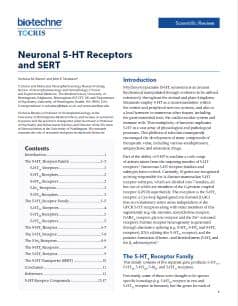5-HT1 Receptors
Serotonin 5-HT1 receptors are a subfamily of 5-HT receptors which bind the neurotransmitter serotonin, also known as 5-hydroxytryptamine. Five subtypes have been identified (5-HT1A, 5-HT1B, 5-HT1D, 5-ht1E and 5-HT1F), all of which are G-protein-coupled receptors that couple to Gi/o causing a decrease in cAMP levels.
5-HT1 Receptor Target Files
Literature for 5-HT1 Receptors
Tocris offers the following scientific literature for 5-HT1 Receptors to showcase our products. We invite you to request* your copy today!
*Please note that Tocris will only send literature to established scientific business / institute addresses.
5-HT Receptors Scientific Review
Written by Nicholas M. Barnes and John F. Neumaier, this review summarizes the various serotonin receptor subtypes and their importance in mediating the role of serotonin in numerous physiological and pharmacological processes. Compounds available from Tocris are listed.
Depression Poster
Major depressive disorder is characterized by depressed mood and a loss of interest and/or pleasure. Updated in 2015 this poster highlights presynaptic and postsynaptic targets for the potential treatment of major depressive disorder, as well as outlining the pharmacology of currently approved antidepressant drugs.
5-HT1 Receptor Data
| Receptor Subtype | 5-HT1A | 5-HT1B | 5-HT1D | 5-ht1E | 5-HT1F |
|---|---|---|---|---|---|
| Transduction Mechanism | ↓Adenylyl Cyclase (Gi/o) | ↓ Adenylyl Cyclase (Gi/o) | ↓ Adenylyl Cyclase (Gi/o) | ↓ Adenylyl Cyclase (Gi/o) | ↓ Adenylyl Cyclase (Gi/o) |
| Primary Distribution | Limbic system (hippocampus, lateral septum, cortical areas), mesencephalic raphe nuclei | Basal ganglia, striatum, amygdala, trigeminal ganglion, vascular smooth muscle | Basal ganglia, hippocampus, cortex, spinal cord, vascular smooth muscle | Cortex, caudate putamen, claustrum, hippocampus, amygdala | Hippocampus, cortex, dorsal raphe nucleus, uterus |
| Function | Hyperpolarization, modulation of neurotransmitter release, anxiolysis, hypothermia, hyperphagia | Autoreceptor, locomotion, hypophagia, hypothermia, modulation of neurotransmitter release, vasoconstriction | Autoreceptor, modulation of neurotransmitter release | Unknown | Speculative role in visual and cognitive function |
| Selective Agonists |
Xaliproden (2491) S 14506 (1771) Ipsapirone (1869) BP 554 (0556) |
CGS 12066B (0638) CP 93129 (1032) CP 94253 (1317) 5-Nonyloxytryptamine (0901) |
L-694,247 (0781) GR 46611 (0864) PNU 142633 (1985) PNU 109291 (2556) |
BRL 54443 (1129) |
BRL 54443 (1129) LY 344864 (2451) LY 334370 (3079) |
| Non-subtype Selective Agonists |
Eltoprazine (1860) 5-Carboxamindotrypt-amine (0458) |
Eltoprazine (1860) 5-Carboxamindotrypt-amine (0458) |
Eltoprazine (1860) 5-Carboxamindotrypt-amine (0458) |
Eltoprazine (1860) 5-Carboxamindotrypt-amine (0458) |
Eltoprazine (1860) 5-Carboxamindotrypt-amine (0458) |
| Selective Antagonists |
MM 77 (0933) NAN-190 (0553) Spiroxatrine (0631) (S)-WAY 100135 (1253) |
GR 55562 (1054) Isamoltane (0992) SB 224289 (1221) NAS-181 (1413) |
BRL 15572 (1207) Cyanopindolol (0993) |
- | - |
| Non-subtype Selective Antagonists |
Pindolol (0994) SDZ 21009 (1516) |
Pindolol (0994) GR 127935 (1054) SDZ 21009 (1516) |
GR 127935 (1054) | - | - |
References
Hoyer et al (1994) VII. International union of pharmacology classification of receptors for 5-hydroxytryptamine (serotonin). Pharmacol. Rev. 46 157. Barnes and Sharp (1999) A review of central 5-HT receptors and their function. Neuropharmacol. 38 1083. Pauwels (2003) 5-HT receptors and their ligands. Tocris Reviews No. 25.

